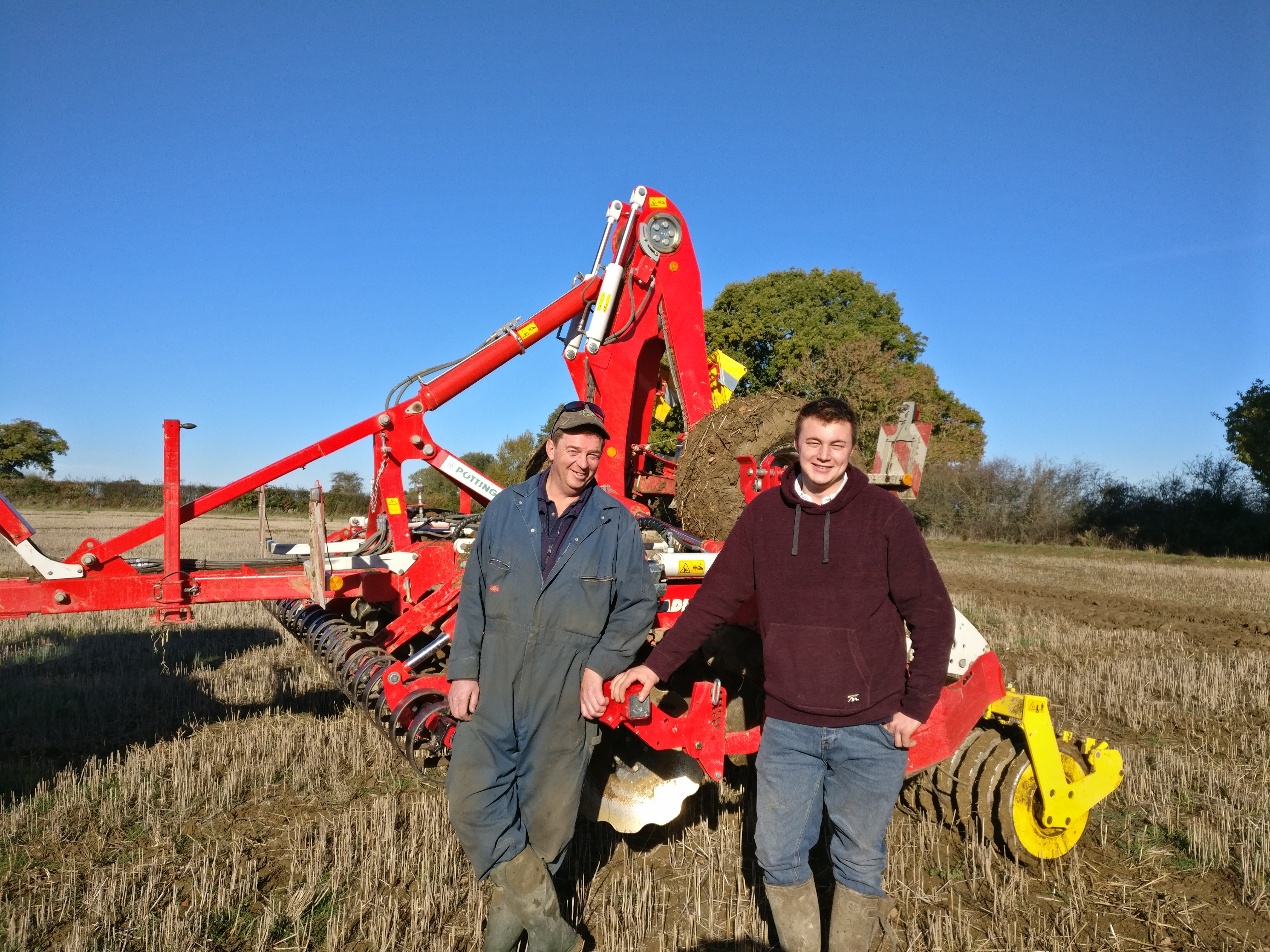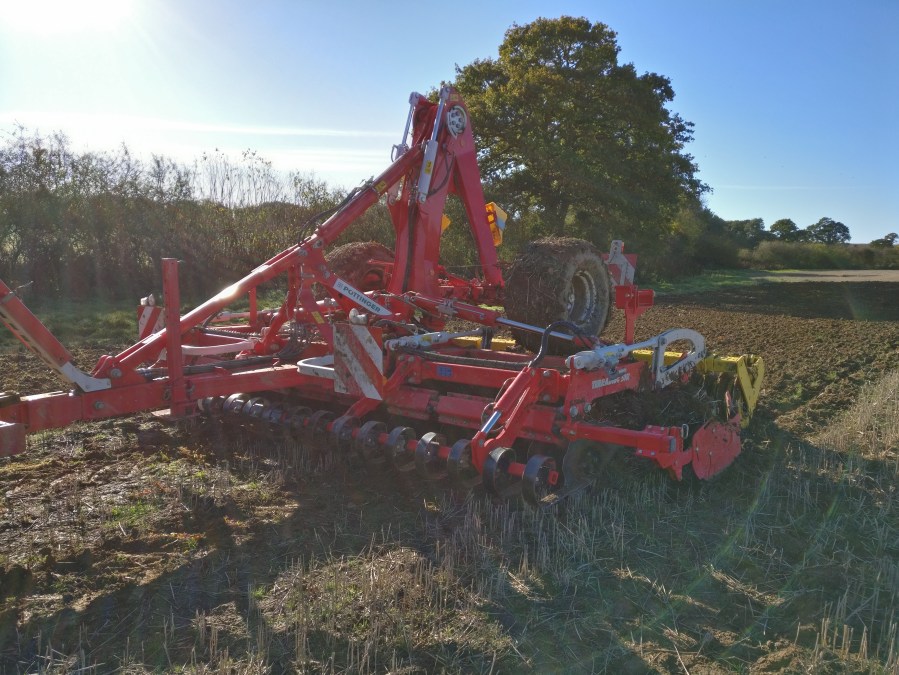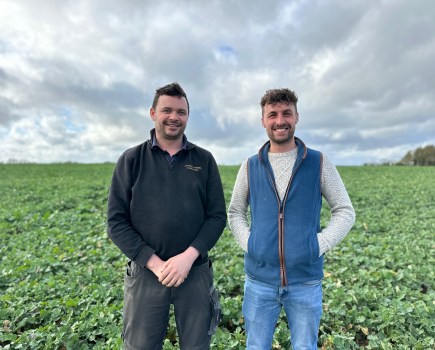The purchase of a new shallow soil cultivator is helping a Sussex-based contractor cut costs and cultivation passes for farmers in the area. CPM visits to find out.
It’s a sturdy build that doesn’t seem to mind brashy or flinty soils.
By Tom Allen-Stevens
It’s the first week of November after a night that put at least 25mm of rain onto the heavy clay soils near Ringmer, E Sussex. No one’s entirely sure whether it’s a good idea to run the 5m Pöttinger Terradisc cultivator through the wheat stubble to see how it performs.
But the result speaks for itself. “Well, you could drill straight into that,” remarks Simon Courtney as the John Deere 6215R comes to a standstill after the brief demo.
And that was the point of the purchase for S&C Courtney, an agricultural contracting business run by Simon and son, Charles Courtney. The business is based at Plashett Park Farm, an 890ha beef and arable unit farmed by Mark Peters, for whom Charles does much of the arable cultivations. “Traditionally Mark has ploughed and power-harrowed all his arable land,” he notes.

Simon (left) and Charles Courtney were keen to expand their range of contracting services into cultivations.
“The farm doesn’t have a good set of discs, so we spotted a gap we thought we could fill. We were also keen to expand our range of contracting services into cultivations.”
Previously an employee of the farm, Charles joined his father’s contracting business last year. This centres around 2600ha of spraying, carried out with a Househam AR3000. There’s also around 1000ha of land covered with a Claas Liner grass rake.
The soil type of the area varies from heavy clay to lighter limestone with a high flint content on the Sussex Downs. Around Tunbridge Wells is some lighter, sandier soil. Much of the contracting operations are carried out for mixed farms in the area, with a plough and power harrow being the default tools to establish the arable crops.
“There’s the opportunity on much of the land around here to move away from the plough to a non-inversion system. That’s especially the case on some of the lighter limestone soils, but some of the clay comes up like boulders, which takes a lot of knocking down with the power harrow,” says Charles.
He started looking around for a cultivator that would bring a seedbed in a single pass, but one that could also be used on the plough when required. “We looked at the Väderstad Carrier XL and Pöttinger’s Terradisc, bringing them both onto the farm for a demo.
“To be honest there wasn’t much between them. Both did a very good job and are well made. In the end it came down largely to the local dealer, Burden Brothers at Framfield, who offered us a good deal on the Terradisc.”
The 5m Terradisc 5001 arrived in Jan in time for spring cultivations this year. The key for Charles is the ability of the machine to go straight into untouched land. “It bites into any stubble and even grassland, which allows for a low input system. It leaves the land suitable for the drill, although it’s not good as the finish you’d get from a power harrow.”
Charles likes the compact design of the machine. “The wheels come down at the back when travelling, but fold up over the machine when in work. That keeps them out the way, so you can back into corners – important in many of the smaller fields we’re operating in. It also adds a bit of weight at the centre of the Terradisc.
“We haven’t had any problems with it, but then there’s not that much to go wrong – apart from the discs there aren’t that many wearing parts, and it’s a sturdy build that doesn’t seem to mind brashy or flinty soils.”
Trapping flints is a key concern in the area. “That’s one thing we’ve seen with other cultivators – they get lodged between the discs and the frame or in the rear roller. When in work, the Terradisc doesn’t seem to have the same problem, although we have noticed the roller can tend to pick them up when you reverse into a corner.”
Maintenance and servicing is very low touch, he adds. “All the discs have sealed bearings, and the greasing points are obvious and easy to access. The only point I grease daily is the one on the headstock. Depth adjustment is a doddle – the rear roller is on hydraulic rams set from the tractor seat, and 5mm spacer plates are brought in to fine-tune the depth control.”
The business’ 215hp JD tractor delivers more than enough grunt to pull the 5m machine, says Charles – it needs around 150-160hp. “We did contemplate a 6m version, but I think the tractor would have struggled on the side of some the downland we cover.”
Charles puts the Terradisc to work at around 12-14km/h. “I can cover around 50ha/day if working biggish fields. Diesel use works out at about 8 l/ha, which isn’t as thirsty as a power harrow.”
The main saving this year was over around 200ha of downland which is usually ploughed, followed by a set of Dalbo paddle rolls. “We went straight into stubble at the end of Sept, and the land travelled very well. We have the levelling Frontboard for knocking down ploughed land, but fields already cultivated tend to slow you down.
“We’ve also opted for the levelling tines that come in between the rear set of discs and the roller. This is to stop any material being thrown by the discs over the roller – I’m not sure whether that would actually be a problem, but it doesn’t drag any material around the field and achieves a good finish.
“That’s been really important in the dry conditions this year – I thought we’d need to do an extra pass to knock out a seedbed, especially on some of the heavier land. But it was really good at crumbling the seedbed and we could follow straight in with the 4m Horsch Sprinter drill,” notes Charles.
“When you get a new machine, it’s always a bit of a gamble, but switching to one pass with the Terradisc has paid off. There are plenty of dairy farms in the area that still like to plough, but those who are switching over are seeing the benefits.”
Terradisc goes large for 2019
Pöttinger’s Terradisc shallow soil cultivator is now available in working widths of 8m and 10m. Premiered at Agritechnica last year, the 8001 T and 10001 T ensure blockage-free incorporation of harvest residues and reliable operation in different operating conditions even with high levels of straw and mulch, says the company.
A working speed of up to 18km/h brings a high output from the new Terradisc, that works to a uniform, shallow (5-15cm) depth to produce a seedbed. It’s a compact design, with an aggressive disc angle and offset configuration of the tools which bring good penetration and mixing in of soil and vegetation even in dry conditions, says Pöttinger.
The two new additions to the Terradisc trailed range bring a choice of working width of 4m, 5m, 6m, and now 8m and 10m. The two rows of 58cm discs bite into the stubble with a Frontboard available as an option to level soil if following the plough, for example. On the left and right, the outermost concave discs are depth adjustable, allowing merging of passes, while edging boards are standard.
The Terradisc features Pöttinger’s Twin Arm system, claimed to optimise the geometry, size, mounting angle and penetration angle of the discs. Two solid forged carrier arms are welded to a wide clamping bracket, keeping the discs at the right position and angle, even in heavy soil or with stones, while hard wheel marks are broken up consistently. Jockey wheels (optional on 8001 T, standard on 10001 T) set the central and hydraulic working-depth setting.
The optional spring steel 14mm-thick adjustable levelling tines deflect the flow of soil to the rear roller, crumbling and levelling the ejected mixture of trash and soil. The Terradisc comes with a choice of rear roller: cage roller, pack ring roller, rubber packer roller and tandem Conoroll. It can optionally be fitted with Pöttinger’s Tegosem catch crop sowing unit to combine soil cultivation and sowing a catch crop in a single pass.
The individual frame sections of the Terradisc T adapt to the ground contours, while on the headland, it’s raised onto the suspension of the rear roller so its weight is distributed across the whole working width. This makes the machine light on its feet both in work and on headlands, says Pöttinger.
Even at the wider working width, the Terradisc T folds to a transport height of 4m and a transport width of 3m. Air brakes or hydraulic brakes are available.
Pre-select functions are used to control the machine as standard, and only three double-acting spool valves are required. An ISOBUS-compatible control system and load-sensing hydraulics are available as an option. For this Pöttinger offers its new Expert 75 ISOBUS terminal – a single-hand control system with a touchscreen and scroll wheel, that can be used with all ISOBUS-compatible machines, says the manufacturer.
- Pöttinger UK will be exhibiting at LAMMA 2019 in Hall 7, stand 7.700.




